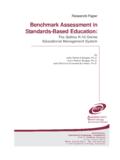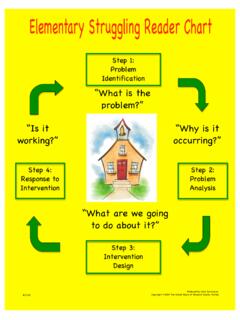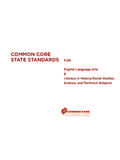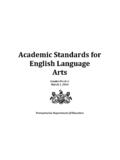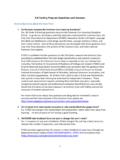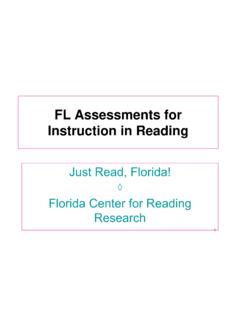Transcription of Building Reading Benchmark Assessments that Align with ...
1 White PaperBuilding Reading BenchmarkAssessments that Align withCommon core State StandardsAssessment Technology, Incorporated6700 E. Speedway Boulevard Tucson, Arizona 85710 Phone: Fax: assessment Technology, Incorporated 2012. All rights Lucas J. Schippers, Copyright assessment Technology, Incorporated 2012. All rights reserved. No part of this document may be reproduced or transmitted in any form or by any means, electronic or mechanical, including photocopy, recording, or any information storage and retrieval system, without permission from the publisher. assessment Technology, Incorporated, Publishers Tucson, Arizona, Printed in the United States of America.
2 V2-071112 Building Reading Benchmark Assessments that Align with Common core State Standards assessment Technology, Incorporated Copyright assessment Technology, Incorporated 2012. All rights reserved. - i - Building Reading Benchmarks Assessments that Align with Common core State Standards By Lucas J. Schippers, assessment Technology, Incorporated Table of Contents Table of Contents .. i I. Introduction .. 1 II. New Standards, New Assessments .. 1 III. Reading in Common core .. 2 IV. Building Valid Common core State Standard Reading Assessments .. 2 V. Discussion .. 3 VI. References .. 4 Building Reading Benchmark Assessments that Align with Common core State Standards assessment Technology, Incorporated Copyright assessment Technology, Incorporated 2012.
3 All rights reserved. - ii - This page intentionally left blank. Building Reading Benchmark Assessments that Align with Common core State Standards assessment Technology, Incorporated Copyright assessment Technology, Incorporated 2012. All rights reserved - 1 - I. Introduction With the implementation of Common core State Standards (CCSS) currently underway, educators are under pressure to respond to a new set of educational expectations. This concern is particularly acute vis- -vis assessment , given the accountability systems in use today. This paper offers guidance to educators who want to ensure that their Benchmark Assessments of Reading effectively measure CCSS.
4 The following questions will be addressed: 1. Why do new standards demand changes to assessment ? 2. What expectations of student readers are present in CCSS? 3. How should Reading Benchmark Assessments be constructed to reflect these expectations? II. New Standards, New Assessments Why should new standards engender changes to an assessment program? Simply put, Assessments that do not evolve along with the standards they purport to measure are of questionable validity. According to the American Educational Research Association, American Psychological Association, and National Council on Measurement in Education, validity is the degree to which accumulated evidence and theory support specific interpretations of test scores entailed by proposed uses (1999).
5 An assessment program can be thought of as an argument in support of the claim that the Assessments are valid for their intended purpose, and for which test scores are collected as evidence; if the argument is logical and reasonable and is supported by evidence, the argument can be said to be valid (Haladyna, 2004). A set of standards typically establishes a body of content knowledge that students are expected to learn. When standards change, so too does the prescribed content knowledge. Updating Assessments to ensure coverage of new content helps guard against loss of content validity ( , the comprehensiveness of a test s measurement of content). However, standards are more than the sum of the content knowledge they prescribe; undergirding a set of standards is a theory of the discipline ( , what it means and entails to be a reader).
6 When this theory is operationalized in curriculum and pedagogy, it becomes a construct, and Assessments that accurately reflect the construct possess construct validity. The format of a test, including the types of items used, influences construct validity (Messick, 1989). Moreover, construct validity is enhanced when the assessment represents disciplinary processes in a way that reflects the theory of the content ( , students read and analyze texts included on a test in accordance with the processes sanctioned by the standards) (Dunbar, Koretz, & Hoover, 1991). In sum, care must be taken in the construction of Assessments to ensure that they measure what they are said to measure.
7 The adoption of a new set of standards brings into sharp relief concerns over an assessment s content and construct validity. Updating the content that is tested as well as the way it is tested helps preserve the validity and usefulness of assessment data. Building Reading Benchmark Assessments that Align with Common core State Standards assessment Technology, Incorporated Copyright assessment Technology, Incorporated 2012. All rights reserved. - 2 - III. Reading in Common core Common core State Standards for English language arts and literacy in history/social studies, science, and technical subjects (2010) develop a construct of Reading characterized by the following assumptions: Students should read more challenging texts.
8 The authors of the standards argue that texts read in schools are not complex and demanding enough to prepare students for the kinds of materials usually encountered in college courses and the workplace. Thus, the standards call for students to engage with increasingly complex texts as they proceed through the grades. Students should read more attentively and respond more deeply to texts. The complexity and depth of analysis mandated by the standards require students to spend significant time and energy Reading texts. Partnership for assessment of Readiness for College and Careers (PARCC), one of two consortia of states working to develop CCSS Assessments , recommends that language arts curricula developed for CCSS emphasize close, sustained analysis of complex text so that students can achieve understanding of the text as a whole (2011, p.)
9 6). Thus, the quality of students Reading and analysis is prioritized over shallow Reading of a greater number of texts. PARCC recommends teaching one long text ( , a novel) per quarter along with an assortment of shorter, thematically complementary texts ( , essays). Students should read more informational text. As per the ratios established by the National assessment of Educational progress , the standards give significant weight to Reading informational text. Students are expected to read informational text in equal measure to literary text in the elementary grades, while the ratio shifts to 70/30 in favor of informational text for high school students. Moreover, high school students are expected to read far more literary nonfiction ( , Patrick Henry s Speech to the Second Virginia Convention ), a kind of informational text, than has traditionally been assigned.
10 Students should write about what they read. Even though Reading and writing are addressed in separate sections in the document, the standards assume that the processes of literacy are integrated in practice. For example, the writing standards directly call upon students to apply in writing what they have learned from their analysis of a text. IV. Building Valid Common core State Standard Reading Assessments The above analysis suggests that Building CCSS Reading Assessments is more than a matter of selecting standards to test. Construct validity can best be achieved by Building Reading Assessments in accordance with the following guidelines: Test items should require analysis of text.

